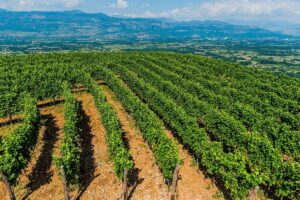Producers and vineyard structure of the Rijeka wine subregion
According to Montenegro’s viticulture registry, grape producers from the Rijeka Subregion make up 5.75% of all registered producers in the country. The subregion’s vineyards, however, cover only 21.36 hectares, which accounts for 0.82% of Montenegro’s total vineyard area.
The vineyards here are typically small-scale and fragmented, reflecting centuries of subsistence viticulture and family winemaking traditions. Producers often manage multiple plots averaging less than a hectare, with vines planted in both mixed and pure vineyards. These conditions favour artisanal, terroir-focused wines rather than mass production.
Grape varieties grown in the Rijeka wine subregion
The diversity of grape varieties is one of the Rijeka subregion’s defining features.
Maraština is the leading grape, covering 48.05% of the vineyard area. Known across the Adriatic as a versatile white grape, Maraština produces fresh, aromatic wines with notes of citrus, Mediterranean herbs, and subtle minerality. It is valued for its balance of acidity and structure, making it suitable for both young wines and barrel-aged styles.
Vranac, Montenegro’s flagship red grape variety, occupies 10.29% of vineyards and appears in 24.07% of mixed plantings. In Rijeka, Vranac often shows a slightly lighter and fresher style, thanks to the cooler microclimates compared to Podgorica or Crmnica.
Other notable grapes that are grown in the Rijeka wine subregion
- Kratošija (4.52%), an ancient Balkan variety, adds red-fruit aromas and finesse.
- Crna Tamjanika (4.12%), a rare aromatic black grape, contributes exotic floral and spicy notes to blends and varietal wines.
- Pinot Noir (2.32%), unusual for Montenegro, benefits from Rijeka’s cooler climate, producing elegant, light-bodied reds.
- Tamjanika Bijela (1.7%), an aromatic white grape, offers muscat-like perfumes of flowers and citrus.
- Pošip (1.41%), a traditional Dalmatian white, shows promise in Rijeka’s soils, adding richness and tropical notes.
- Lisičina (0.73%) and Smederevka (0.71%) round out the assortment, maintaining genetic diversity in local vineyards.
Terroir and climate of the Rijeka wine subregion
The Rijeka Subregion is shaped by karst landscapes, rocky soils, and moderate elevations, which together create a unique viticultural environment. Soils are generally shallow, stony, and rich in limestone, conditions that restrict vine vigour but encourage concentration in the grapes.
The climate is a mix of Mediterranean and continental influences, moderated by Skadar Lake. Summers are hot and sunny, ensuring ripening of red varieties, while cooler nights and higher altitudes preserve acidity — especially beneficial for Maraština, Pošip, and Pinot Noir.
This balance makes Rijeka particularly suitable for producing aromatic whites and lighter, elegant reds, a profile distinct from the more robust wines of Crmnica or Podgorica.
Tradition and potential of the Rijeka wine subregion
Viticulture in Rijeka dates back centuries, with families cultivating vines for household consumption and local markets. Historically, wines from this area were valued for their freshness and drinkability, often consumed young.
Today, with a renewed focus on quality over quantity, the subregion is gaining attention for its potential to craft boutique wines that showcase indigenous varieties alongside international grapes.
For wine professionals, Rijeka offers a living laboratory where Maraština and Crna Tamjanika can be explored as signature varietals, while Pinot Noir and Pošip represent exciting experiments in adaptation. For casual wine enthusiasts, Rijeka provides wines that are approachable, aromatic, and food-friendly, pairing beautifully with Montenegrin coastal cuisine.
4 wineries of Rijeka wine subregion in Montenegro


